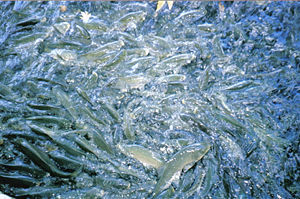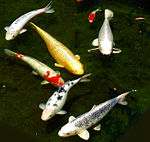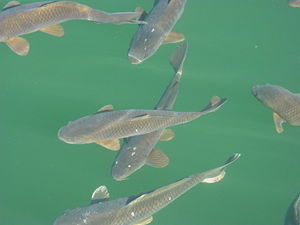Difference between revisions of "Carp" - New World Encyclopedia
Rick Swarts (talk | contribs) (added most recent Wikipedia version) |
m (Remove parent category) |
||
| Line 125: | Line 125: | ||
{{credit|Carp|158236466}} | {{credit|Carp|158236466}} | ||
| − | |||
Revision as of 01:22, 20 September 2007
| Carp | ||||||||||
|---|---|---|---|---|---|---|---|---|---|---|
 Common carp, Cyprinus carpio
| ||||||||||
| Scientific classification | ||||||||||
| ||||||||||
|
Abramis |
Carp is a common name for various freshwater fish of the family Cyprinidae, a very large group of fishes that dominates the fish faunas of Eurasia and North America. Some consider all cyprinid fishes carp and the family Cyprinidae itself is often known as the carp family. In colloquial use, however, carp usually refers only to several larger cyprinid species such as Cyprinus carpio (common carp), Carassius carassius (Crucian carp), Ctenopharyngodon idella (grass carp), Hypophthalmichthys molitrix (silver carp), and Hypophthalmichthys nobilis (bighead carp). Carp have long been an important food fish to humans as well as popular ornamental fishes (see koi and goldfish). As a result, carp have been introduced to various locations.
Human introductions of carp
Carp originate in Asia, and it was on carp that the first text on aquaculture, Fan Lee's "Treatise on Pisciculture," was written in 473 B.C.E. Carp were introduced to England from western Europe during the 13th century, when they were cultivated mainly by monks. They were subsequently introduced into North America in 1877. Fish were released in ponds in Druid Hill Park in Baltimore, Maryland. Later, surplus populations were released in Washington D.C.. This was a project of Rudolf Hessel, a fish culturist in the employ of the United States Government. There was substantial favorable publicity and carp were widely introduced throughout the United States. Introduced Carp readily adapted to their new environment, spreading rapidly throughout any drainage area in which they were released. Carp have since become naturalized in almost every water in which they were introduced.
Eating and sport
While tasty when grown in clean water, carp tend to have small bones and fish that live in muddy waters can acquire a muddy flavor.[1] The value of carp as food varies. In China, Japan, and Taiwan carp are esteemed as food fish and are also considered to be signs of good fortune, so are often served at banquets and other formal meals.[citation needed] In Central and Eastern Europe, carp are also much appreciated, and are traditionally eaten on Christmas Eve in the Czech Republic, Slovakia, Germany, Croatia, Hungary and Poland.[citation needed] In the Australia, UK and North America, on the other hand, carp are rarely eaten.[citation needed] The common carp is one of the most aquacultured consumption fish in the world, produced in the hundreds of thousands of tons annually.
Carp are similarly variable in terms of angling value. In Europe even when not fished for as food they are eagerly sought out by anglers, being considered wily fish that are difficult to hook.[1] Lake owners are prepared to pay as much as £4000 for 40 lb (18 kg) carp if fisherman fish for them on a catch and release basis.[citation needed] In the United States, on the other hand, the carp has not yet gained gamefish status and in the northern states at least is sometimes considered a trash fish of no value.[2]
Carp are an important subsistence aquaculture product, and have been cultivated in complex polycultures since the 7th century AD. Grass carp, silver carp and common carp were common during the Tang dynasty in China (618-907 C.E.) due to their dissimilar feeding habits. Grass carp are fairly unique in that they eat live plant matter with pharyngeal grinding teeth, on which they will feed continuously at the proper temperatures, consuming several times their body weight in grass per day. The other two species are filter feeders, herbivorous and omnivorous respectively. These are often used in a grass/fish polyculture, but historically one of the important food production systems in China has, on a subsistence level, been rice/fish culture. The fish provide not only human nutrition, but crop fertilizer, and can increase rice yields per hectare. However, this system tends to be compatible only with small operations using genotypically lower-yielding tall rice varieties and is not feasible on a commercial scale. Other polycropping systems involving carp include livestock/carp (in which livestock wastes fertilize carp ponds, or more indirectly fertilize row crops whose green manure fertilises the ponds), and carp/sericulture (in which pond silt is used to fertilize mulberry trees that support silkworm populations.
Ornamental carp
Carp, along with many of their cyprinid relatives, are popular ornamental aquarium and pond fish. The two most notable ornamental carps are goldfish and koi. Goldfish (Carassius auratus) were kept as ornamental fish in China for hundreds of years before being introduced to Japan in the 15th century, and to Europe in the late 17th century. The koi, a domesticated variety of common carp (Cyprinus carpio), was also originated from China and widely spread in Japan. The koi are historically a prevalent symbol in Japanese culture of good luck. They are shown in fish shows like those at the All Japan show. They are also popular in other parts of the world as pond fish. Goldfish and koi have advantages over most ornamental fishes, as they are tolerant of cold (they can survive in temperatures as low as 4 degrees Celsius), and can survive low oxygen levels.
Carp as pests
Carp have been introduced, often illegally, into many countries. In some countries, due to their habit of grubbing through bottom sediments for food and alteration of their environment, they destroy, uproot and disturb submerged vegetation causing serious damage to native duck and fish populations. In Australia there is enormous anecdotal and mounting scientific evidence that introduced carp are the cause of permanent turbidity and loss of submerged vegetation in the Murray-Darling river system, with severe consequences for river ecosystems, water quality and native fish species.
Efforts to eradicate a small colony from Tasmania's Lake Crescent without chemicals have been successful, however the long-term, expensive and intensive undertaking is an example of both the possibility and difficulty of safely removing the species once it is established.
Carp have attributes that allow them to be an invasive species - a species that invades and dominates new ecosystems with serious negative effects to the ecosystem and native fauna, earning the reputation as "rough fish".
introduction to carp in australia
when the british and english started moving to aystralian in the mid 1800's, the brang along with them a spot fish, known today as carp. It was used as a sportfish until it was found that the carp wat destroying the native fish of australia. Today people are trying the bast in every which way to get rid of the pest fish...or Carp
Types of carp

- Genus Abramis
- Carp bream (Abramis brama)
- Genus Aristichthys:
- Bighead carp (Aristichthys nobilis)
- Genus Barbodes:
- Carnatic carp (Barbodes carnaticus)
- Genus Carassius:
- Crucian carp (Carassius carassius )
- Prussian carp (Carassius gibelio)
- Goldfish (Carassius auratus)
- Genus Cirrhinus:
- Chinese mud carp (Cirrhinus chinensis)
- Deccan white carp (Cirrhinus fulungee)
- Hora white carp (Cirrhinus macrops)
- Small scale mud carp (Cirrhinus microlepis)
- Mud carp (Cirrhinus molitorella)
- Genus Ctenopharyngodon:
- Grass carp (Ctenopharyngodon idellus)
- Genus Culter:
- Predatory carp (Culter erythropterus)
- Genus Cyprinus:
- Common carp, Koi (Cyprinus carpio)
- Genus Epalzeorhynchos:
- Red-tailed black shark (Epalzeorhynchos bicolor)
- Red-finned black shark or Rainbow shark (Epalzeorhynchos frenatus)
- Genus Henicorhynchus:
- Siamese mud carp (Henicorhynchus siamensis)
- Genus Hypophthalmichthys:
- Silver carp (Hypophthalmichthys molitrix)
- Genus Labeo:
- African carp (Labeo coubie)
- Fringed-lipped peninsula carp (Labeo fimbriatus)
- Bigmouth carp (Labeo kontius)
- Genus Mylopharyngodon:
- Black carp (Mylopharyngodon piceus)
Connection to legends
In Chinese Mythology, there is said to be a place called Dragon's Gate. Dragon's Gate resides at the top of a waterfall. It is said if a carp can jump over the waterfall from the waters below, it will become a beautiful dragon.
See also
- Oily fish
- Asian carps (a term used heavy-bodied cyprinids native to China and Southeast Asia)
- Grass carp
ReferencesISBN links support NWE through referral fees
- ↑ 1.0 1.1 A. F. Magri MacMahon (1946). Fishlore, pp 149-152. Pelican Books.
- ↑ http://www.big-river.com/br.story.a.html Carp — Queen of Rivers or Pig With Fins? November 1993
External links and further readings
- Information regarding carp fishing
- Gulf States Marine Fisheries Commission
- Carp:Queen of Rivers or Pig With Fins? by Pamela Eyden, November 1993
- Carp Fishing in France
- Carp Forum
Credits
New World Encyclopedia writers and editors rewrote and completed the Wikipedia article in accordance with New World Encyclopedia standards. This article abides by terms of the Creative Commons CC-by-sa 3.0 License (CC-by-sa), which may be used and disseminated with proper attribution. Credit is due under the terms of this license that can reference both the New World Encyclopedia contributors and the selfless volunteer contributors of the Wikimedia Foundation. To cite this article click here for a list of acceptable citing formats.The history of earlier contributions by wikipedians is accessible to researchers here:
The history of this article since it was imported to New World Encyclopedia:
Note: Some restrictions may apply to use of individual images which are separately licensed.

